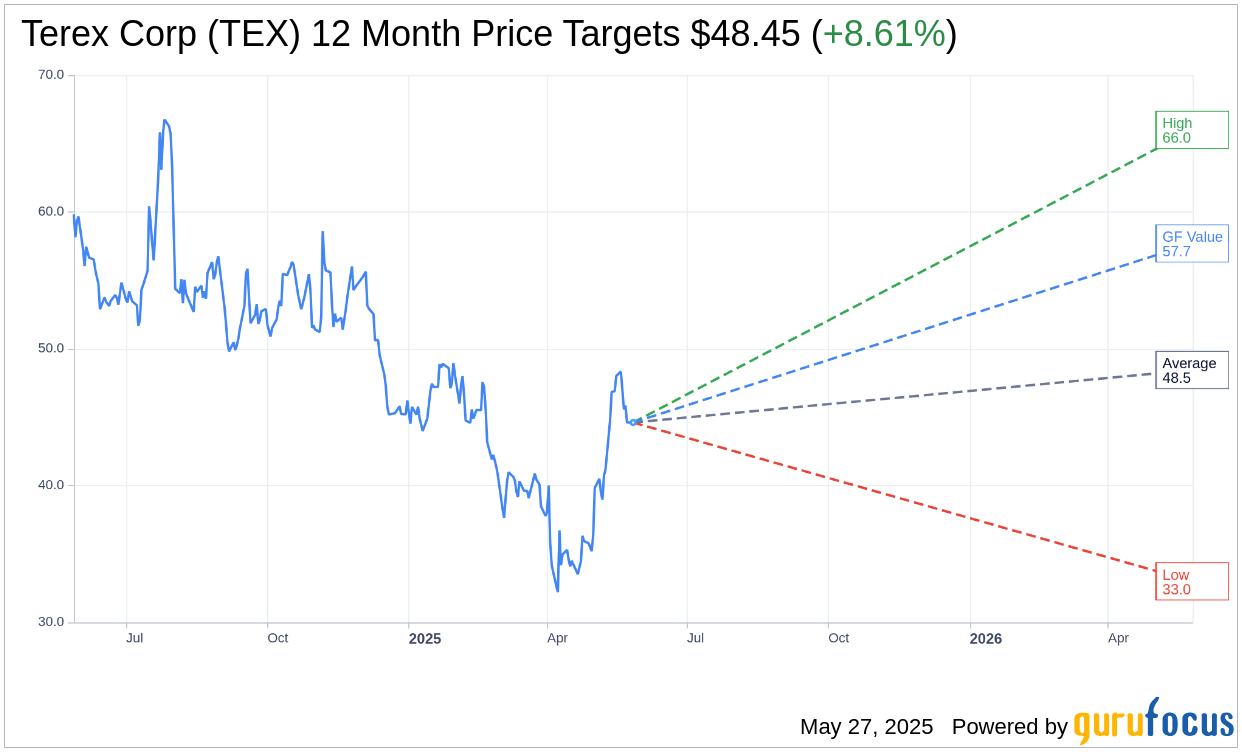Goldman Sachs has raised its rating on Terex (TEX, Financial) from Neutral to Buy, increasing the price target from $45 to $60. The upgrade is driven by expectations of a turnaround in the company's Aerials segment, which is projected to bottom out in the first quarter. This outlook comes amid a significant 30% reduction in production and a book-to-bill ratio that is 15% higher than the historical average, indicating potential growth.
Furthermore, current inventory levels suggest an improvement in the supply situation, lending additional support to the positive forecast. The firm also notes that the risks associated with tariffs are already considered in the stock's market value. This comprehensive analysis suggests a bullish perspective on Terex's future performance.
Wall Street Analysts Forecast

Based on the one-year price targets offered by 10 analysts, the average target price for Terex Corp (TEX, Financial) is $48.45 with a high estimate of $66.00 and a low estimate of $33.00. The average target implies an upside of 8.61% from the current price of $44.61. More detailed estimate data can be found on the Terex Corp (TEX) Forecast page.
Based on the consensus recommendation from 13 brokerage firms, Terex Corp's (TEX, Financial) average brokerage recommendation is currently 2.8, indicating "Hold" status. The rating scale ranges from 1 to 5, where 1 signifies Strong Buy, and 5 denotes Sell.
Based on GuruFocus estimates, the estimated GF Value for Terex Corp (TEX, Financial) in one year is $57.70, suggesting a upside of 29.34% from the current price of $44.61. GF Value is GuruFocus' estimate of the fair value that the stock should be traded at. It is calculated based on the historical multiples the stock has traded at previously, as well as past business growth and the future estimates of the business' performance. More detailed data can be found on the Terex Corp (TEX) Summary page.
TEX Key Business Developments
Release Date: May 02, 2025
- Revenue: $1.2 billion, a 4.9% decrease from the prior year.
- Earnings Per Share (EPS): $0.83.
- Operating Margin: 9.1%, a decrease of 350 basis points from the prior year.
- Return on Invested Capital: 15%.
- Backlog: $2.6 billion, up 13% sequentially.
- Book-to-Bill Ratio: 124%.
- Environmental Solutions Operating Margin: 19.4%.
- Interest and Other Expenses: $41 million, $26 million higher than last year.
- Effective Tax Rate: 21%.
- Free Cash Flow: Improved compared to Q1 last year.
- Liquidity: $1.1 billion.
- Share Repurchase: $32 million in Q1.
- Dividends Paid: $11 million in Q1.
- Full Year EPS Outlook: $4.70 to $5.20.
- Full Year Sales Outlook: $5.3 billion to $5.5 billion.
For the complete transcript of the earnings call, please refer to the full earnings call transcript.
Positive Points
- Terex Corp (TEX, Financial) exceeded its initial Q1 financial outlook, delivering earnings per share of $0.83 on sales of $1.2 billion.
- The Environmental Solutions segment achieved a strong operating margin of 19.4%, contributing significantly to the company's overall performance.
- The company maintained a strong backlog of $2.6 billion, up 13% sequentially, indicating robust demand.
- Terex Corp (TEX) is leveraging its US-centric manufacturing footprint, with approximately 75% of its 2025 US machine sales expected to be generated by products made in the US.
- The company is on track to deliver more than $25 million in operational run rate synergies by the end of 2026, driven by the integration of ESG.
Negative Points
- Terex Corp (TEX) experienced a 4.9% decline in total net sales compared to the prior year, with organic sales declining by 25% year-over-year.
- Operating margins were impacted by production cuts in the Aerials and MP segments, resulting in a 350 basis point decline compared to the prior year.
- The company faces challenges from tariffs, with an assumed $0.40 net tariff impact included in the full-year outlook.
- The European market remains weak, posing a headwind for the Materials Processing segment.
- Interest and other expenses increased by $26 million year-over-year due to interest on ESG reposition financing.
